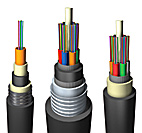cable, vdsl, patch
How to Install Fiber Optic Cable- Installing Fiber Optic Cable-How To Install A Fiber Optic Cable Between Buildings- How To Install Fiber Optic Cable In Your Home- How To Add To Extend Your CAT 5e Network
NOW WE GET TO WHERE THE RUBBER MEETS THE ROAD - THE INSTALLATION OF A Building A To Building B- Length 1000 Feet -FIBER OPTIC ABLE THAT WILL TIE IN YOUR COMPUTER SYSTEM. WHETHER YOU NEED TO EXTEND YOUR NETWORK IN A COMMERCIAL AREA OR A RESIDENTIAL AREA- THE FOLLOWING MATERIALS AND PRODUCTS ARE REQUIRED. (1) FIRST STEP Attach your computer network to a fiber optic media converter - You would need to get a patch cable first to tie in your computer's router to the fiber optic media converter. Plug the patch cord into your router and into one end of the fiber optic media converter. Please visit our CAT 5E and CAT 6 Patch Cords Page: we have lengths from 1 foot to over 200 feet. In some applications if the run is short enough- you may want to run our pre- assembled outdoor rated CAT 5E cable from your computer network to your remote computer. Please find below our pricing and engineering specifications on outdoor rated CAT 5E cable. STEP 1 STEP 2 GETTING THE RIGHT FIBER OPTIC MEDIA CONVERTER Fiber Optic Media Converters-More Info on media converters - we will assist you in getting the right part numbers-we need to fist determine the total length of the fiber optic cable run, the speed, and then we have to determine if the fiber cable will be singlemode or multimode and then the fiber optic connectors you will be using. We will find a cost effective solution for your network.
(3) STEP THREE -Connect Your Router via a CAT 5E or CAT 6 Patch Cord Into Your Fiber Optic Media Converter
STEP 4 - Installing Your Fiber Optic Cable
Additional How To Install Fiber Optic Cable Installation Tips!
STEP 5- Getting Your Fiber Optic Cable Inside Your House Or Business
(6) STEP SIX - Plugging In Your Fiber Optic Cable and Connetor to Your Fiber Optic Media Converter
Additional Links and TIPS On Fiber Optic Cable and Installing Fiber Optic Cable HANDLING FIBER OPTIC CABLE REDUCING LOSS BY PROPERHANDLING GENERAL INSTALLATION TIPS
• Always follow the manufacturer's guidelines forminimum bend radius and tension. Failure to do so may result in high attenuation and possible damage to the fiber optic cable. Guidelines are normally supplied with the cable manufacturer specification sheets. If the bend radius specifications are unknown, the industry de facto standard is to maintain aminimum radius of 20X the diameter of the fiber optic cable. • Manufacturers may give two specifications for bothradius and tension. These are called Static and Dynamic specifications. "Dynamic" is the specification during the cable installation or while cable is under load, and "Static" is the specification for after installation is complete. • If using tie-wraps, remember not to distort the shape of the fiber optic cable, as this adds pressure onto the optical fibers. • Install fiber cables in a sequence that applies the least amount of strain on the cable. • Identify fiber cable at all likely access points (ceiling access, etc.). • Sharp bends increase cable tension, so it is best to install optic cable in sequences that minimize stress. • Use sheaths and cable guides to maintain recommended cable bend radius. • Monitor tension, and maintain racking bend radius. • Protect exposed fiber cables from vehicular and public traffic. • Prior to installation, double-check actual fiber count. • Always follow engineering and construction placement and route plans. • Always follow National Electrical Code guidelines, as well as local and state codes. • Maintain good communications between installation personnel. • When installing loose-tube cable, use a silicone injection or sealer to prevent gel migration. • For underground installation, center-pull long cables. Store excess cable in vaults/manholes, and identify optical cables with markers. • Aerial installation: Use proper hardware matchingcable, span and tension requirements. Use correct cable jacket. • Buried Cable Installations: Identify cable locations with surface markers. Anticipate obstructions PULLING FIBER LONG DISTANCES For extremely long pulls, the cable can be removed at a manhole further down the installation route. Figure-eight or zigzag the cable while the pulling equipment is moved to the next manhole site. Following these guidelines should help to make thecable installation uneventful and successful. Below find different fiber cable types Simplex and Zip Cord: Simplex cables are one fiber, tight-buffered (coated with a 900 micron buffer over the primary buffer coating) with Kevlar (aramid fiber) strength members and jacketed for indoor use. The jacket is usually 3mm (1/8 in.) diameter. Zipcord is simply two of these joined with a thin web. It's used mostly for patch cord and backplane applications, but zipcord can also be used for desktop connections. In the diagrams below please find below pictures indicating the PC tower or File Server ethernet signal being converted and extended via fiber optic cable. Click On The Pictures Below For Specific Information On How To Use Your Outdoor CAT 5E Cable Using The Aerial Method Or the Underground Method.
To RUN YOUR ETHERNET SIGNAL MORE THAN 300 FEET WITHOUT WIRELESS- By USING FIBER OPTIC CABLE Here Are Some Simple Steps and Recommendations- If you run into problems- feel free to call us at (866) 342-3721 for FREE engineering assistance
(1) Diagram (1)In this diagram below you see two networks-the GRAYLINE indicating a LAN that ties in any commuter system using CAT 5e or CAT 6 ethernet UTP copper cable to a media converter and or a switch and the RED LINE or LINK Below indicating up to a 2 kilometer link using fiber optic cable. The fiber optic cable in this diagram shows using singlemode fiber optic cable. In many situations one can use multimode cable that is rated as an 'indoor- outdoor' fiber optic cable as well- instead of a singlmode cable. The other important components in designing your system in knowing the length of your cable runs- and always include a minimum of 10% additional cable for "overage" or miscalculation. You would hate to have a 1000 foot custom fiber optic cable made - only to find out you needed 1025 feet! You also need to let us know what type of fiber optic CONNECTORS you ned that will connect the FIBER OPTIC MEDIA CONVERTER to the FIBER CABLE. Typically most people use SC or ST, LC being used mostly for commercial applications which use Cisco routers or other higher end switches and routers.
(2) Diagram (2) In this diagram you clearly see the PC on the left- it could be your office , home or any locations. The PC is plugged into your ethernet switch or router (or sometimes both).Then there is an ethernet CAT 5e patch cord or CAT 6 patch cable tying the ethernet switch to the fiber optic media converter.The signal goes into the fiber optic media converter- GETS CONVERTED into digital light pulses which go through the other end of the fiber cable into your other media converter. The fiber optic media converter can be from 10Mbps-100- 1000 or a multi use media converter with several speeds. The YELLOW LINE indicates a fiber optic cable which can be mulitmode or singlemode- and this distance can be from 100 meters to 80 kilometers. You also need to let us know what type of fiber optic CONNECTORS you ned that will connect the FIBER OPTIC MEDIA CONVERTER to the FIBER CABLE. Typically most people use SC or ST, LC being used mostly for commercial applications which use Cisco routers or other higher end switches and routers.
We can supply you with all part numbers and have everything pre-configured and pre- assembled from the patch cords to the fiber optic cable to the media converters- ALL WE NEED TO DO IS ASK YOU A FEW questions: You need to tell us is what lengths you need, the speeds, and the throughput. We will design at NO COST to you a solution the SAME DAY and typically ship the SAME DAY the product to you-provided you do not require customization in your network. A typical network would be something like this:
Outdoor rated CAT 5e patch cords-outdoor rated patch cables- outdoor CAT 6 patch cords are used to extend the ethernet (your computer signal) outdoors over aerial cables, underground through HDPE or pvc conduit, or direct bury with our direct bury rated CAT 5e cables. Please See Our Outdoor CAT 5e Cable Specifications SPECS- Our Outdoor Rated CAT 5e patch cords and Outdoor Patch Cables are pre-cut to a specific length- then terminated on both ends - tested and shipped the same day
Offer Valid with 25 or more boxes sold- see terms and conditions
Stub Cable- Transition Cable-PE 89, 25 Pair PE 89, Copper Telecom Cables,Seal Pic FSF PE 89- Transition Cables- Seal Pic FSF PE 39- Stub Cables- Direct Bury Copper Telecom Cables-Icky Pick
Plenum Innerduct Carries PE – 89 Communication Cable which comes in a six (6) pair cable configurations up to 2400 pairs manufactured for the purpose of direct burial systems communication applications in accordance with the National Electric Code.Conductor construction is soft drawn bare copper meeting the requirements of ASTM Specification B-3. The conductors are 22 awg solid copper.The conductors are insulated with polyethylene (PE) in distinctive colors to facilitate pair identification and are twisted into pairs with varying lays to minimize crosstalk.The interstices between the pairs are filled with an 80 C filling compound and covered with a low density, high molecular weight black polyethylene (PE).Plenum Innerduct Carries a complete line of stub cable, transition cable, andPE 89 direct bury copper telephone cables including the Seal Pic FSF PE 89 and Seal Pic FSF PE 39 cables which come in 25 pair to 200 pair PE 89 configurations. The PE 89 or Seal Pic FSF PE 89 and Seal Pic FSF PE 39 cables are used for distribution and long distance networks. The Seal Pic FSF 89 comes in 22 gauge and 24 gauge copper cable. The Seal Pic FSF 39 cables come in 19 gauge and 22 gauge coper. These cables are installed into ducts. One of our manufacturers, Hesfibel provided the majority of the recent Times Warner build out and operates on the principle of minimum error and the provision of high quality products and total customer satisfaction. Hesfibel has been awarded the TSE-ISO 9002 quality certification since 1993.
For More Information On Any of the Products Below- Just click on the Pictures -More Information and Specifications For PE 39 and PE 89 Below PE 89 Application: Stub Cable Description:
Application: Suitable for use as direct burial communication applications where protection against water and moisture entry is a critical requirement. PE – 89 is recommended where rodent attack is possible.SEAL PIC-FSF is designed as a duct, aerial or direct burial cable in either exchange area service or trunk service. The core is filled with an 80 degree Centigrade filling compound and the sheath interfaces are flooded with a flooding compound. The polymer coating provides additional corrosion protection for the aluminum shield. Construction: Conductor: Soft drawn bare copper (ASTM Spec. B-3). Solid (22 awg) The assembly is then wrapped with two metal shield tapes: - A corrugated .008" thick polymer coated aluminum tape and a corrugated .006" polymer coated steel tape. REA PE-89
CONDUCTOR: Solid annealed bare copper, sizes 19 AWG (.9mm ), 22 AWG (.64mm), and 24 AWG (.5mm). INSULATION: Inner layer of foamed natural polyolefin covered by outer layer of solid colored polyolefin, color coded in accordance with standard telephone industry code. TWISTED PAIRS: Individual conductors twisted into pairs with varying lays to minimize crosstalk and with specified color combinations to provide pair identification. CABLE ASSEMBLY: Cables having 25 pairs or less are assembled in a single group. Cables having more than 25 pairs are assembled in units, each individually identified by color coded unit binders. The interstices between the pairs are filled with an 80 degree Centigrade filling compound. CORE COVERING: Non-hygroscopic dielectric tape. SHIELD: SEALPIC-FSF-Electrically continuous 0.008 in. (0.2mm) thick polymer coated, corrugated aluminum tape applied longitudinally with overlapped edges and flooded with a flooding compound. JACKET: Black polyethylene.
Home | Cables | Switches | Contact Us | Our Team | Locations
|











 Plenum Innerduct has created this "How to Install Fiber Optic Cable, How To Install A Fiber Optic Cable Between Buildings, How To Install Fiber Optic Cable In Your Home, How To Add To Extend Your CAT 5e Networkand How To Add To Extend Your CAT 5e Network more than 300 feet as a courtesy to our customers and visitors to our website. While we provide 175,000 products from fiber optic able to data center equipment to residential Smart Home Systems- and all have one thing in common- to make your life easier through providing products to imrove the world's communication. Below we will explain to you in layman terms how to install fiber optic cable. In this section we will aid you in determining what equipment you will need to install fiber optic cable as well as the cost and part numbers in installing your fiber optic cable.
Plenum Innerduct has created this "How to Install Fiber Optic Cable, How To Install A Fiber Optic Cable Between Buildings, How To Install Fiber Optic Cable In Your Home, How To Add To Extend Your CAT 5e Networkand How To Add To Extend Your CAT 5e Network more than 300 feet as a courtesy to our customers and visitors to our website. While we provide 175,000 products from fiber optic able to data center equipment to residential Smart Home Systems- and all have one thing in common- to make your life easier through providing products to imrove the world's communication. Below we will explain to you in layman terms how to install fiber optic cable. In this section we will aid you in determining what equipment you will need to install fiber optic cable as well as the cost and part numbers in installing your fiber optic cable. 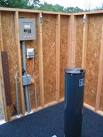 Plenum Innerduct can assist not only commercial installation of fiber optic cable - but we can also assist developers (FTTH- more info) in planning a revenue generating program for the lifetime of the development by installing not only finer optic cable- but the entire infrastructure of cable to each and every home in their development. In this section Plenum Innerduct will assist you the homeowner to install your own fiber optic cable so you may extend your ethernet and computer service further than 300 feet - to another remote building. We get quite a few requests each week on how to extend computer networks or ethernet signals more than the industry standard of 90 meters. To assist the homeowner or home based businessman , boat owner, rural property owner, resort operator, etc.how to extend the ethernet signal- we created this simple -layman's terminology to explain in black and white how anyone can install a fiber optic cable themselves and save a lot of money.
Plenum Innerduct can assist not only commercial installation of fiber optic cable - but we can also assist developers (FTTH- more info) in planning a revenue generating program for the lifetime of the development by installing not only finer optic cable- but the entire infrastructure of cable to each and every home in their development. In this section Plenum Innerduct will assist you the homeowner to install your own fiber optic cable so you may extend your ethernet and computer service further than 300 feet - to another remote building. We get quite a few requests each week on how to extend computer networks or ethernet signals more than the industry standard of 90 meters. To assist the homeowner or home based businessman , boat owner, rural property owner, resort operator, etc.how to extend the ethernet signal- we created this simple -layman's terminology to explain in black and white how anyone can install a fiber optic cable themselves and save a lot of money. 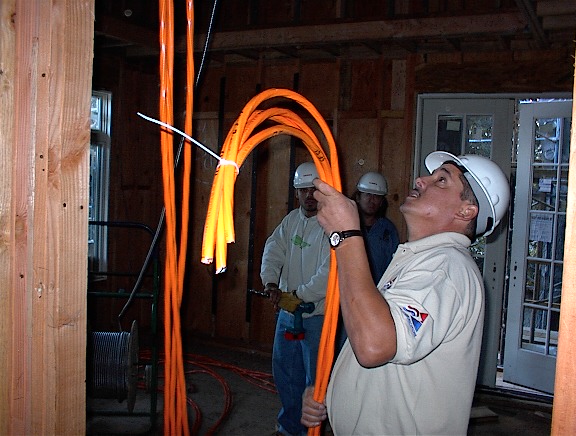 Plenum Innerduct will also discuss with you the benefits and or drawbacks of installing fiber optic cable overhead- via an aerial method or underground. Any fiber optic cable that you decide to use should be rugged and or UV resistant- depending how you plan on installing your fiber optic cable. Whether you buy from us or not- remember that any fiber optic cable that you may buy from us or anyone else must be an 'indoor -outdoor " rated fiber optic cable.This means that if you are going from outside your home or office and into your home or office (see picture below) that you should always use the indoor outdoor rated type of fiber optic cable.
Plenum Innerduct will also discuss with you the benefits and or drawbacks of installing fiber optic cable overhead- via an aerial method or underground. Any fiber optic cable that you decide to use should be rugged and or UV resistant- depending how you plan on installing your fiber optic cable. Whether you buy from us or not- remember that any fiber optic cable that you may buy from us or anyone else must be an 'indoor -outdoor " rated fiber optic cable.This means that if you are going from outside your home or office and into your home or office (see picture below) that you should always use the indoor outdoor rated type of fiber optic cable.
 We have included below a simple Q&A's - questions and answers along with examples on how to install your fiber optic cable and CAT 5e aerial cable, CAT 5e underground cable, and extend your CAT 5e and CAT 5E cable and ethernet network when wireless will not work. We will also explain that one should not extend the signal more than the EIA-TIA 568 A-B specifications and standards allow the extension of an ethernet signal for a maximum of 90 meters or 290 feet. There are exceptions where the local provider of services will 'guarantee' the signal traveling more than 290 feet- including
We have included below a simple Q&A's - questions and answers along with examples on how to install your fiber optic cable and CAT 5e aerial cable, CAT 5e underground cable, and extend your CAT 5e and CAT 5E cable and ethernet network when wireless will not work. We will also explain that one should not extend the signal more than the EIA-TIA 568 A-B specifications and standards allow the extension of an ethernet signal for a maximum of 90 meters or 290 feet. There are exceptions where the local provider of services will 'guarantee' the signal traveling more than 290 feet- including 






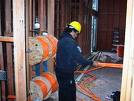 Installing your Fiber Optic Cable Via Aerial means or direct bury underground or in conduit. We provide pre-cut lengths that are tested- ruggedized and ready to install into your fiber optic media converters . Our fiber optic assemblies or fiber optic patch cords are made into pre-determined lengths with the fiber optic connectors already placed and terminated on the ends of the cable along with a 'pulling eye'. The pulling eye enable you to pull the fiber optic cable several hundred - and thousand feet without damaging your cable- REMEMBER-
Installing your Fiber Optic Cable Via Aerial means or direct bury underground or in conduit. We provide pre-cut lengths that are tested- ruggedized and ready to install into your fiber optic media converters . Our fiber optic assemblies or fiber optic patch cords are made into pre-determined lengths with the fiber optic connectors already placed and terminated on the ends of the cable along with a 'pulling eye'. The pulling eye enable you to pull the fiber optic cable several hundred - and thousand feet without damaging your cable- REMEMBER-  Fiber Optic Assembly-
Fiber Optic Assembly- Always
use a Fiber Optic Pulling Eye to pull your fiber optic assembly
in the conduit or innerduct. The pulling eye is designed to
take the stress off the cable while pulling the fiber optic
cable -
Always
use a Fiber Optic Pulling Eye to pull your fiber optic assembly
in the conduit or innerduct. The pulling eye is designed to
take the stress off the cable while pulling the fiber optic
cable - Never leave fiber optic cable or data cable lying on the ground-it's pretty obvious isn't it?
Never leave fiber optic cable or data cable lying on the ground-it's pretty obvious isn't it?  On Aerial Fiber Optic Cable Installs: If you are installing
fiber optic cable via aerial means- between building and amongst
other cable types-
On Aerial Fiber Optic Cable Installs: If you are installing
fiber optic cable via aerial means- between building and amongst
other cable types-  Never Pull your fiber cable on an offset- or angle! This may
damage the fiber cable- connectors-or both
Never Pull your fiber cable on an offset- or angle! This may
damage the fiber cable- connectors-or both 







 This all weather Super CAT 5e cable is an outdoor rated CAT 5e cable that can be installed directly in the ground, inside a duct or aerially lashed to a support member. We carry several varieties of outdoor CAT 5e cable from the CMX direct bury for underground uses, the CMXT for UV above ground, aerial and in conditions where a light shielding is required, and the CMXFT CAT 5e outdoor cable for aerial applications. The CMX CAT 5e direct bury cable is fully flooded and has a tough UV and abrasion resistant black polyethylene jacket. The cable is designed to withstand temperatures as low as -70degrees C (Celsius) and as high as 75 degrees C. Data transmission rates are up to 100Ms/second. These cables are the ideal solution for connecting LAN terminal locations outside the main building such as portable classrooms without the need to use expensive optical fiber systems .Optional aluminum or steel shielding systems provide additional protection for EMI and damage caused by rodents.
This all weather Super CAT 5e cable is an outdoor rated CAT 5e cable that can be installed directly in the ground, inside a duct or aerially lashed to a support member. We carry several varieties of outdoor CAT 5e cable from the CMX direct bury for underground uses, the CMXT for UV above ground, aerial and in conditions where a light shielding is required, and the CMXFT CAT 5e outdoor cable for aerial applications. The CMX CAT 5e direct bury cable is fully flooded and has a tough UV and abrasion resistant black polyethylene jacket. The cable is designed to withstand temperatures as low as -70degrees C (Celsius) and as high as 75 degrees C. Data transmission rates are up to 100Ms/second. These cables are the ideal solution for connecting LAN terminal locations outside the main building such as portable classrooms without the need to use expensive optical fiber systems .Optional aluminum or steel shielding systems provide additional protection for EMI and damage caused by rodents. 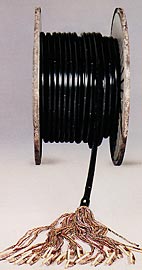 Stub Cable- Stub Cable is factory process filled cable that is cut to customer specified lengths eliminating time-consuming cable preparation at the customer job site. The Stub Cable features a factory installed pneumatic cable "block" on one end of the cable (a variety of cable types are available; 22, 24, 26 gauge cable with pair counts from 50 to 1800 pair sizes). The cable block prevents air and/or filling compound leakage from pressurized cable plant to non-pressurized cable plant. The cable block is typically located 120 inches from one end of the cable and is sealed using state of the art blocking compounds. The cable block is small in diameter relative to the cable diameter to minimize obstructions and clearances from adjacent cable plant.
Stub Cable- Stub Cable is factory process filled cable that is cut to customer specified lengths eliminating time-consuming cable preparation at the customer job site. The Stub Cable features a factory installed pneumatic cable "block" on one end of the cable (a variety of cable types are available; 22, 24, 26 gauge cable with pair counts from 50 to 1800 pair sizes). The cable block prevents air and/or filling compound leakage from pressurized cable plant to non-pressurized cable plant. The cable block is typically located 120 inches from one end of the cable and is sealed using state of the art blocking compounds. The cable block is small in diameter relative to the cable diameter to minimize obstructions and clearances from adjacent cable plant.


 Field Kits
Field Kits Mode
Conditioning Cables
Mode
Conditioning Cables  Fiber
Jumpers
Fiber
Jumpers 




